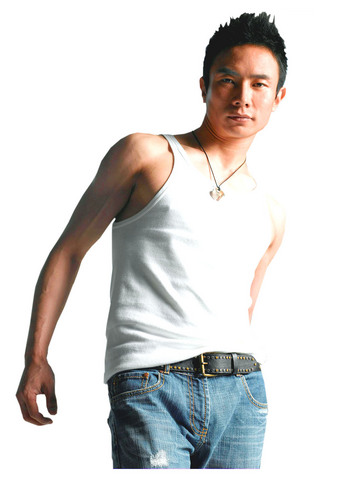A handsome but controversial young Tibetan lama has emerged on the local music scene by releasing his first CD — a collection of rap and hip-hop songs that he claims can help promote Buddhism.
Singa Rinpoche (盛噶仁波切), 30, who is barred from entering Taiwan due to his flamboyant behavior on a visit to the island last year, released the CD — Wish You Well (我要你幸福) — on Saturday through Taiwanese Forward Music company.
Since then, several TV channels have been airing the MTV spots promoting Singa's album — showing Singa recording songs in the studio, running in a forest and releasing a bird into freedom.

PHOTO COURTESY OF FORWARD MUSIC
Wearing his trademark white shirt and blue pants, Singa, 179cm tall and weighing 63kg, shows a natural talent for performing by flashing smiles and making poses, showing off his youth and confidence.
Singa signed a contract with Forward Music last April and began recording at a Beijing studio in July.
"We were surprised by the public response to this CD. It is selling extremely well. We have opened a blog for Singa Rinpoche and within a week, 100,000 people have browsed it," a Forward Music (豐華唱片) press officer said.
Most of the 12 songs on the CD were written and composed by a Taiwan musician and two were written and composed by Singa.
They are: Reincarnation, Wish You Well, Let Me Take Care of You, Fashion, It's the Light, Girl Quji Zhuoma, Starting to Realize, Leave Love to You, Today, Lama Chino.
In the songs, Singa mixes rap and hip-hop with chants of Buddhist sutras, and switches from Chinese to Tibetan and English.
The songs deal mostly with love, but he also preaches his philosophy. The song Leave Love to You has this rap line: All the pain in this world is caused by seeking happiness for himself/All the joy in this world is caused by seeking happiness for others.
Born in Qinghai Province, China, in 1970, Singa claims a rainbow appeared in the sky when he was born. At 16, a Tibetan monastery confirmed he was the reincarnation of a high lama.
Singa claimed he spent three years studying Buddhism in Nepal, Tibet and Thailand, before traveling around the world to spread Buddhism.
But when he visited Taiwan from February to April last year to promote his book, This Is Me, a living Buddha, he caused controversy because he acted more like a film star than a monk. He wore trendy clothes and received his disciples wearing a shirt and jeans, not the red cloak worn by Tibetan lamas.
Some Taiwan disciples alledged Singa had not finished Buddhist studies in India and had not been ordained, prompting the Interior Ministry to bar him from entering the country for one year.
Cheng Chen-huang (鄭振煌), a internationally recognized Buddhist scholar, believes Singa Rinpoche has violated Buddhist precepts, or moral codes.
"There are 250 precepts for a Chinese Buddhist and 253 precepts for a Tibetan Buddhist. For a Buddhist, these codes are very important and must be observed," Cheng said.
Agga Wandha, a 59-year-old Burmese monk in Taipei, agreed.
"The essence of Buddhism is to quench desires in order to achieve inner peace. Singa Rinpoche's wearing fashionable clothes and driving fancy cars shows he is feeding these desires," he said.
But Singa Rinpoche's behavior is nothing new to Tibetan Buddhism. Three hundred years ago, the sixth Dalai Lama raised eyebrows because he frequented Lhasa's red light district at night and wrote love poems.
A more recent example is Dzongsar Khyentse Rinpoche from the Himalayan Buddhist kingdom of Bhutan, who directed two films — The Cup in 1999 and Travellers and Magicians in 2005.
Dzongsar Khyentse received world acclaim for his films and continues to travel around the world to preach Buddhism.

The Nuremberg trials have inspired filmmakers before, from Stanley Kramer’s 1961 drama to the 2000 television miniseries with Alec Baldwin and Brian Cox. But for the latest take, Nuremberg, writer-director James Vanderbilt focuses on a lesser-known figure: The US Army psychiatrist Douglas Kelley, who after the war was assigned to supervise and evaluate captured Nazi leaders to ensure they were fit for trial (and also keep them alive). But his is a name that had been largely forgotten: He wasn’t even a character in the miniseries. Kelley, portrayed in the film by Rami Malek, was an ambitious sort who saw in

It’s always a pleasure to see something one has long advocated slowly become reality. The late August visit of a delegation to the Philippines led by Deputy Minister of Agriculture Huang Chao-ching (黃昭欽), Chair of Chinese International Economic Cooperation Association Joseph Lyu (呂桔誠) and US-Taiwan Business Council vice president, Lotta Danielsson, was yet another example of how the two nations are drawing closer together. The security threat from the People’s Republic of China (PRC), along with their complementary economies, is finally fostering growth in ties. Interestingly, officials from both sides often refer to a shared Austronesian heritage when arguing for

Among the Nazis who were prosecuted during the Nuremberg trials in 1945 and 1946 was Hitler’s second-in-command, Hermann Goring. Less widely known, though, is the involvement of the US psychiatrist Douglas Kelley, who spent more than 80 hours interviewing and assessing Goring and 21 other Nazi officials prior to the trials. As described in Jack El-Hai’s 2013 book The Nazi and the Psychiatrist, Kelley was charmed by Goring but also haunted by his own conclusion that the Nazis’ atrocities were not specific to that time and place or to those people: they could in fact happen anywhere. He was ultimately

Last week gave us the droll little comedy of People’s Republic of China’s (PRC) consul general in Osaka posting a threat on X in response to Japanese Prime Minister Sanae Takaichi saying to the Diet that a Chinese attack on Taiwan may be an “existential threat” to Japan. That would allow Japanese Self Defence Forces to respond militarily. The PRC representative then said that if a “filthy neck sticks itself in uninvited, we will cut it off without a moment’s hesitation. Are you prepared for that?” This was widely, and probably deliberately, construed as a threat to behead Takaichi, though it